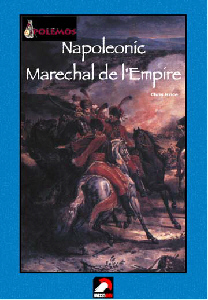|
|
|||||||||||||||||||||||||||||
 |
|
The Rules Directory only works if you help. Write a review. Get the review template here. |
|
TITLE: Polemos Napoleonic Marechal d’Empire (2006) AUTHOR: Chris Grice PUBLISHER: AdSigna Publications www.adsigna.ca PUBLICATION DATE: 2006 WEBSITE: Baccus Home Page There is also a Yahoo group which supports all of the rules sets in the Polemos family. PRICE: £15 (Includes Polemos General de Division ruleset) REVIEWED BY: Chris Grice (Author) PERIOD COVERED: Napoleonic period. THE BOOK: This is an A4, 84 page booklet including both Polemos General de Division and Marechal d’Empire rulesets. Covers and four central pages are in full colour, the latter comprising photographs of the rules in action. There are two card quick reference sheets, one for each set of rules. SCOPE: These rules allow the major battles of the Napoleonic period to be played. ARMY SIZE: A typical army would include 30 – 50 bases of figures. The rules are intended for use with 6mm figures and a base will accommodate four to six strips of 6mm figures. BASE UNIT: A brigade of infantry or cavalry or between 12 and 24 guns. GAME SCALES:
BASING SIZES: Bases are square, but can be made up of two General de Division bases butted up against each other. The rules recommend 60mm by 60mm bases, but it is not vital that this is adhered to, so long as both armies use the same basing system. TURN SEQUENCE:
GAME MECHANICS: At the start of each game turn, both players will attempt to gain the initiative. They have a number of Tempo Points, calculated according to the number of generals present with the army. Each player chooses to bid some of these points with the highest bidder gaining the initiative for that game turn. The points remaining are used to issue orders to the army. Larger forces (e.g. corps) must build up command points before they are able to move, but once in motion they are much easier to keep moving. Narrower formations – columns of march – move faster but the force should stop to redeploy before making contact with the enemy. Thus sweeping Napoleonic manoeuvres are possible. Each contact between opposing forces is fought as a self-contained action involving four combat rounds and an outcome round, after which the loser of the contact falls back. As casualties mount, formations become spent and take no further part in the fighting. When too many formations are spent, the army is broken in defeat. ARMY LISTS: The rules include an army generator section, which will generate a typical force of approximately the size desired by the player, for any of the following armies:
A sourcebook is currently (June 2008) in the course of production which will include, among other things, a series of new armies for the generator, a number of historical scenarios including all the most famous battles of the Napoleonic Wars, including Austerlitz, Borodino and Waterloo, and a complete campaign. COMMENTS: Some problems encountered during formatting meant that the first edition of the rules suffered from a number of production errors. An errata sheet is available on the Baccus website. The second edition of the rules is nearing completion (June 2008) and will address these problems plus add some new material. The rule book also includes Polemos General de Division, a ruleset for smaller Napoleonic battles. The same bases may be used for both rulesets. Marechal d’Empire also includes a set of suggested campaign rules. The intention of Marechal d’Empire rules is to enable the players to fight even the largest battle of the Napoleonic Wars to a conclusion within a few hours, give a reasonable historical outcome and not leave the players with a headache from too many calculations. A PLAYER’S COMMENTS: “The overall concept is brilliant and all the different phases blend together in a very well thought out way. If you want to game something that is fresh, clever, easy to play (once learned), fast, and very much a Napoleonic command feeling game, then this is it. We believe that Marechal de l'Empire has clearly raised the bar on Napoleonic big battle miniature gaming.” To provide your own comments, or read those of other gamers, please click here. |
|
[Home] [15mm World] [Reviews Home] [How To] [Beginners Guide] [Gamer's World] [Spanner & The Yank] [Points of View] [The Annex] [Links] [Say Howdy] [Corporate Schill] [Rules Directory] |
 |
